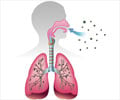The structure of a protein that helps a common fungus to infect the body has been unlocked by a team of scientists.

"In this study, we determined the three-dimensional structure of a never-before-seen cell wall protein called SOD5 that the organism uses as a defense against the human immune system," said P. John Hart, Ph.D., the Ewing Halsell-President's Council Distinguished Professor of biochemistry at the UT Health Science Center and Research Scientist in the South Texas Veterans Health Care System.
"SOD5 is a copper-only protein that exhibits significant structural differences from copper/zinc superoxide dismutases (SODs)," Dr. Hart said. "Because SOD5 molecules are widespread throughout fungi, including C. albicans, but are not found in humans, the structural differences can be exploited to develop compounds that specifically target SOD5 to treat a number of widespread fungal infections."
Current conventional antifungal treatments such as fluconazole can be toxic to the liver in certain individuals, he noted.
"SOD5 is an unprecedented, very powerful antioxidant protein that enables C. albicans to ward off free radicals of the host immune response," said study senior author Valeria Culotta, Ph.D., professor of biochemistry and molecular biology and environmental health sciences at the Johns Hopkins University Bloomberg School of Public Health. Free radicals are highly reactive molecules that can cause oxidative damage.
Advertisement












